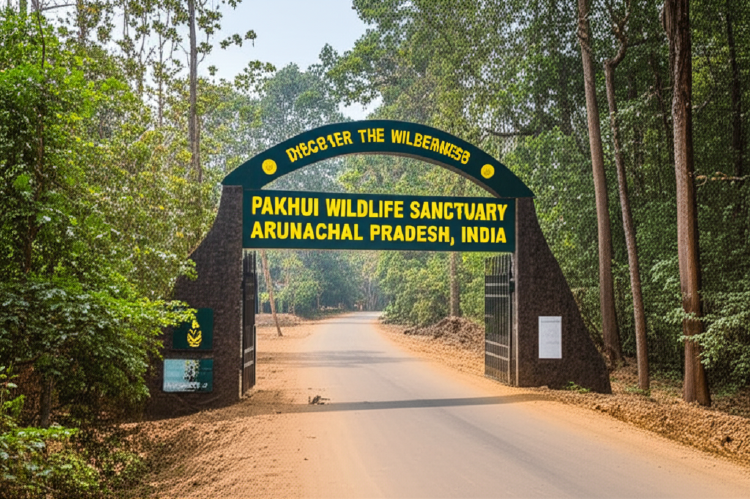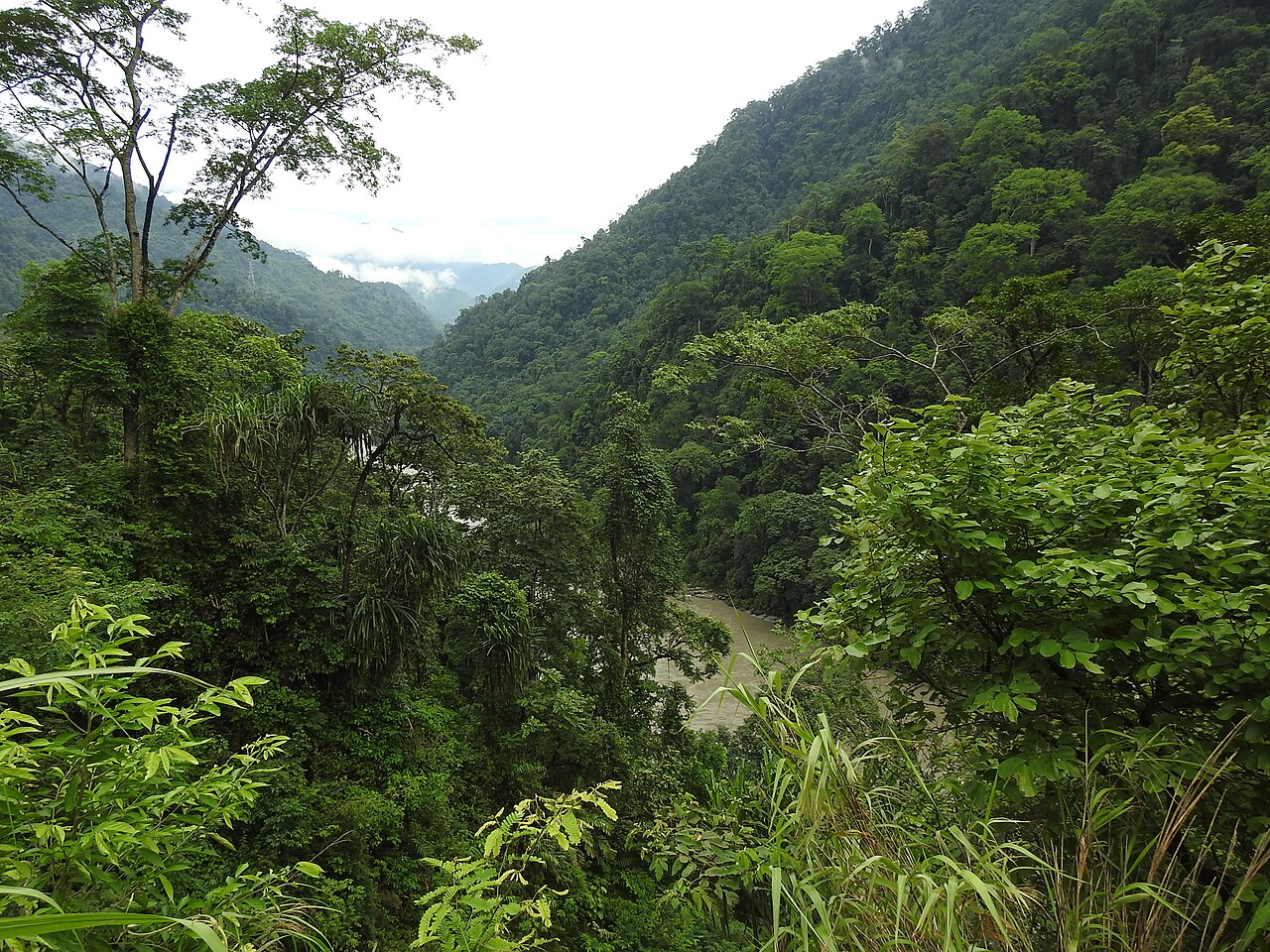Discover the Wilderness at Pakhui Wildlife Sanctuary, Arunachal Pradesh
Located in the East Khasi Hills district of Arunachal Pradesh, Pakhui Wildlife Sanctuary is a must-visit destination for nature lovers and adventure seekers. Spread over an area of 68,900 hectares, this sanctuary is home to a diverse range of flora and fauna, including elephants, tigers, leopards, and bears. Take a guided trek through the dense forests and experience the thrill of spotting wildlife in its natural habitat.
- Muthukrishnan
- 7 min read

Introduction
Pakhui Wildlife Sanctuary, a hidden gem nestled in the verdant embrace of Arunachal Pradesh, India, offers a captivating blend of biodiversity and untamed beauty. This sanctuary is a haven for wildlife enthusiasts and nature lovers alike. Perched at varying elevations, the sanctuary’s rugged terrain and dense forests are a testament to the Eastern Himalayas’ unique ecosystem. While Ziro is famous for its beautiful valley and Apatani tribe culture, the Pakhui Wildlife Sanctuary offers an entirely different and equally enriching experience. The sanctuary’s proximity to other popular destinations in Arunachal Pradesh makes it an accessible destination for a diverse range of travellers. Pakhui is unique for its dense tiger population, diverse avian life, and relatively undisturbed natural environment.
History and Cultural Heritage
The history of Pakhui Wildlife Sanctuary is interwoven with the traditions of the indigenous communities of the area, primarily the Nyishi tribe. Historically, these forests were integral to their way of life, providing sustenance and resources. The colonial influence in the region was limited, but the area’s significance as a biodiversity hotspot gradually came to light. The sanctuary itself was formally established in 1977 and later upgraded to a tiger reserve in 2002.
The local culture, though not directly within the boundaries of the sanctuary itself, significantly influences the surrounding regions. The Nyishi people’s traditions, colourful festivals, and spiritual beliefs resonate throughout the area. Festivals like Mopin (celebrated by the Galo tribe, not specifically in the sanctuary’s immediate vicinity) are vibrant displays of community bonding and offer a glimpse into the rich cultural tapestry of Arunachal Pradesh. The traditional villages that border the sanctuary often house important community centres and religious structures, reflecting the deep spiritual connection the people have with the natural world.

Natural Beauty
Pakhui Wildlife Sanctuary is an epitome of Himalayan beauty. Its landscape is dominated by dense evergreen forests, interspersed with rolling hills and deep valleys carved by numerous rivers and streams, including the Pakhui River, after which it is named. The sanctuary’s varied elevation gives rise to a wide range of vegetation, including sal, teak, and various species of orchids. The dense canopy provides a home for a rich variety of wildlife.

The Kameng River, which flows through the Pakke Tiger Reserve (another name for Pakhui Wildlife Sanctuary), adds to the sanctuary’s scenic beauty. The river’s crystal-clear waters, surrounded by lush green forests, create a picturesque landscape that is a treat for nature lovers and photographers alike.
Specific viewpoints within the sanctuary, accessible through guided treks, offer breathtaking vistas of the surrounding valleys and the distant snow-capped peaks of the Himalayas. The sanctuary is renowned for its pristine and undisturbed nature. Visitors can immerse themselves in the tranquility and the raw beauty of the landscape.
Must-Visit Attractions
The main attraction within Pakhui Wildlife Sanctuary is the opportunity to experience its incredibly rich biodiversity.
- Wildlife Viewing: The primary activity is to observe the diverse species of animals, including tigers, elephants, gaurs, clouded leopards, and various species of deer. Guided safaris and nature walks are the best way to experience this.
- Bird Watching: The sanctuary is a paradise for birdwatchers, offering a chance to spot numerous species of birds, including the rare and elusive Great Hornbill, the Rufous-necked Hornbill, and many others.
- Nature Trails: Embark on guided nature trails through the dense forests, allowing you to explore the flora and fauna up close and personal.
- River Adventures: While the infrastructure is still developing, there are opportunities for river-based experiences like boating and exploring the riverbanks.
Adventure Activities
Pakhui offers some adventure activities:
- Jungle Treks: Guided treks through the sanctuary’s dense jungles offer an exhilarating way to explore the terrain and spot wildlife.
- Wildlife Safaris: Jeep safaris provide an opportunity to traverse through the sanctuary and catch a glimpse of animals in their natural habitat.
- Bird Watching: Pakhui is a birdwatcher’s delight. Pack your binoculars and prepare to spot a variety of bird species.
- Camping: In select areas, camping might be permitted, allowing visitors to immerse themselves in the night sounds of the jungle.
Local Markets and Handicrafts
Since the sanctuary is in a relatively remote location, and this location does not include Ziro, the availability of markets within the immediate vicinity is limited. However, visiting nearby towns and villages, offers a glimpse into local handicrafts.
- Handloom and Textiles: The Nyishi people are known for their traditional handloom products, including colourful shawls, bags, and clothing items.
- Bamboo Crafts: Bamboo is abundant in the region, and you can find a variety of items, like baskets, mats, and decorative pieces.
- Wood Carvings: Some artisans create intricate wooden carvings, often depicting tribal motifs and animal figures.
Food and Cuisine
The cuisine of the region is simple and organic. The local food primarily consists of rice, vegetables, and meat, prepared with simple spices.
- Traditional Dishes: Try local dishes like Peh (rice cooked with meat or vegetables), Thukpa (noodle soup), and Apong (local rice beer).
- Street Food: Local restaurants offer a variety of snacks and meals with regional flavours.
- Local Restaurants: Look for restaurants that are authentic and serve traditional recipes, but always confirm with your guides or the locals regarding the best available options.
Flora and Fauna
Pakhui Wildlife Sanctuary is a treasure trove of biodiversity.
- Flora: The sanctuary’s vegetation is diverse, encompassing evergreen forests, and various species of orchids and medicinal plants.
- Fauna: The sanctuary is home to various wildlife species, including tigers, elephants, gaurs (Indian bison), clouded leopards, sambar deer, barking deer, and a variety of primates.
- Birds: It is a birdwatcher’s paradise, with a vast population of over 300 bird species, including hornbills, pheasants, eagles, and many migratory birds.
Best Time to Visit
The ideal time to visit Pakhui Wildlife Sanctuary is during the winter months, from November to March. The weather is pleasant and the chances of spotting wildlife are higher. The climate is relatively dry and ideal for jungle treks and safaris.
During the summer months (April to June), the weather can be hot and humid. The monsoon season (July to October) brings heavy rainfall, making travel and wildlife spotting difficult.
How to Reach
- Nearest Airport: Tezpur Airport in Assam is the closest airport, approximately 190 km away. From the airport, you can hire a taxi or take a bus.
- Nearest Railway Station: Rangapara North Railway Station in Assam is the nearest railway station, about 150 km from the sanctuary.
- Road: The sanctuary is accessible by road. Regular buses and taxis are available from Guwahati (Assam) and Itanagar. The roads are well maintained. The distance from Itanagar is approximately 190km.
Accommodation Options
Accommodation options in and around Pakhui are limited. Due to its remote nature, choices vary between budget-friendly accommodations to basic lodges:
- Forest Rest Houses: The Arunachal Pradesh Forest Department maintains rest houses within the sanctuary. Booking in advance is highly recommended.
- Basic Lodges: Basic lodges are available in the nearby towns, offering essential amenities for a comfortable stay.
- Homestays: Opportunities for homestays are developing, offering a chance to experience the local way of life.
Offbeat Experiences
For a more authentic experience, venture beyond the mainstream:
- Village Visits: Visit nearby tribal villages and interact with the locals to learn about their culture and traditions.
- Nature Walks: Engage in guided nature walks to explore the lesser-known trails of the sanctuary.
- Cultural Interactions: Participate in cultural programs, if any, to learn about the local arts, music, and dance forms.
- Photography: The sanctuary offers excellent opportunities for photography.
Conclusion
Pakhui Wildlife Sanctuary is a destination that embodies the untouched beauty and rugged wilderness of Arunachal Pradesh. A visit to Pakhui offers a unique experience, from the opportunity to witness wildlife in its natural habitat to immersive experiences with the local culture. It is a haven for nature lovers, adventure enthusiasts, and anyone seeking to escape the ordinary. Explore the lush forests, encounter the diverse wildlife, and create lasting memories.